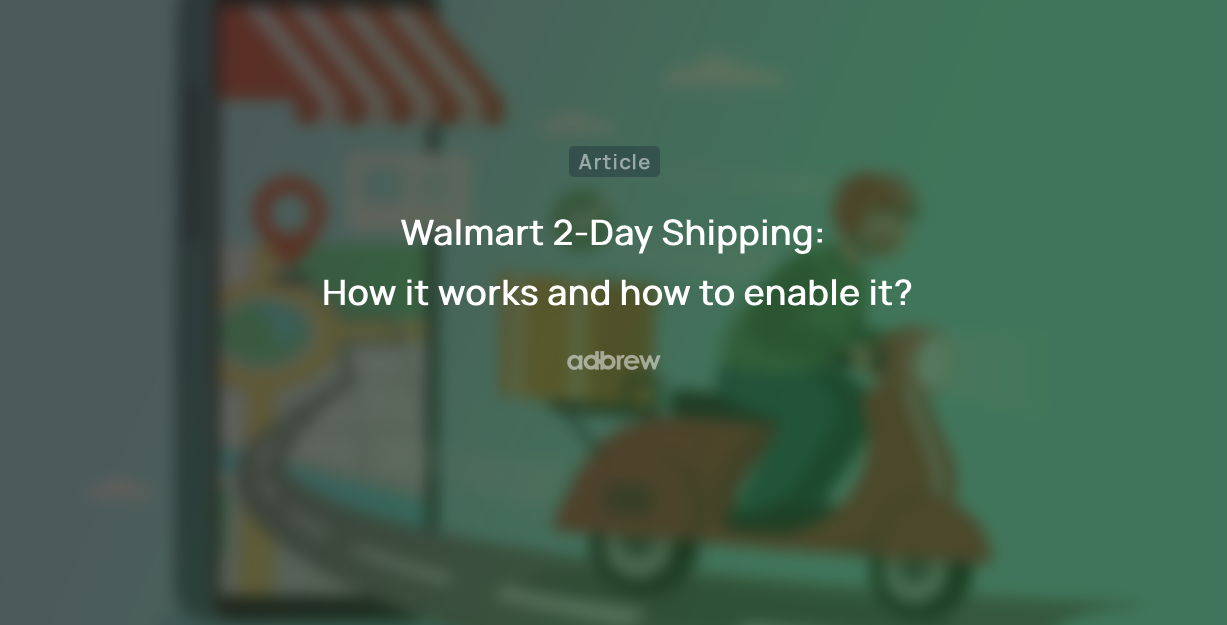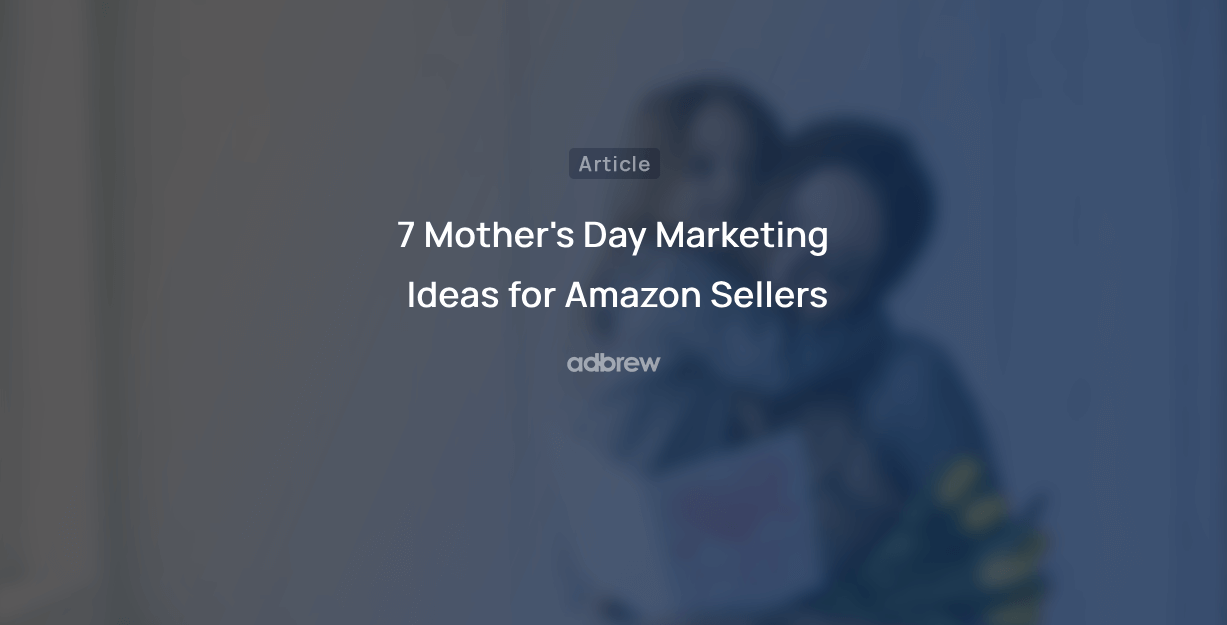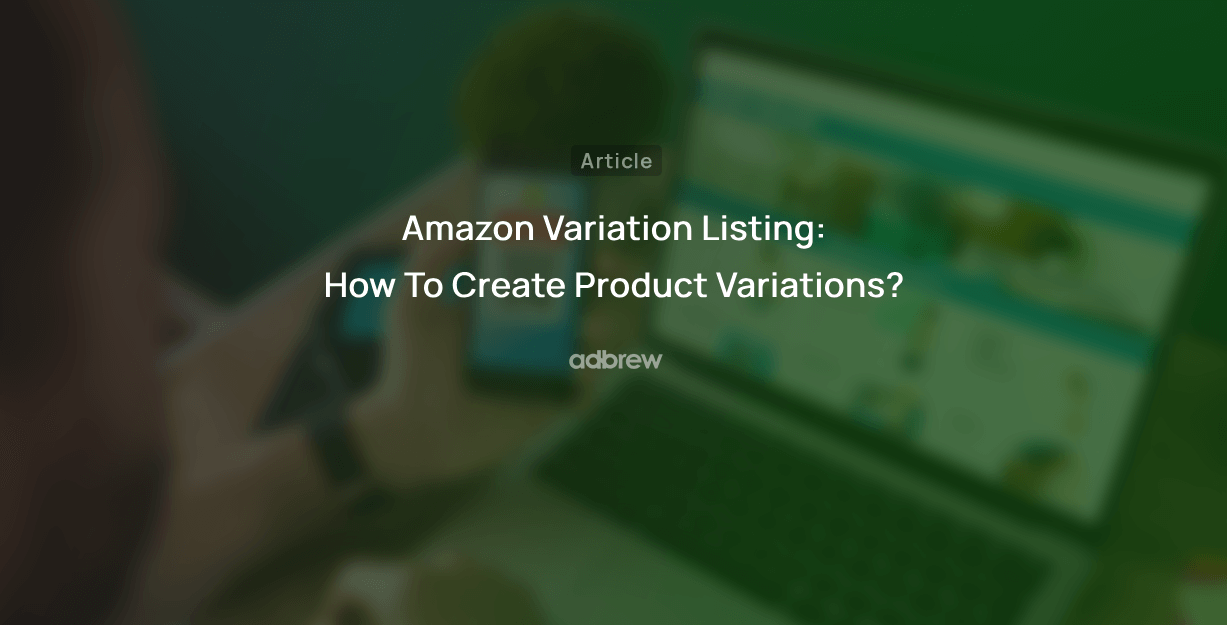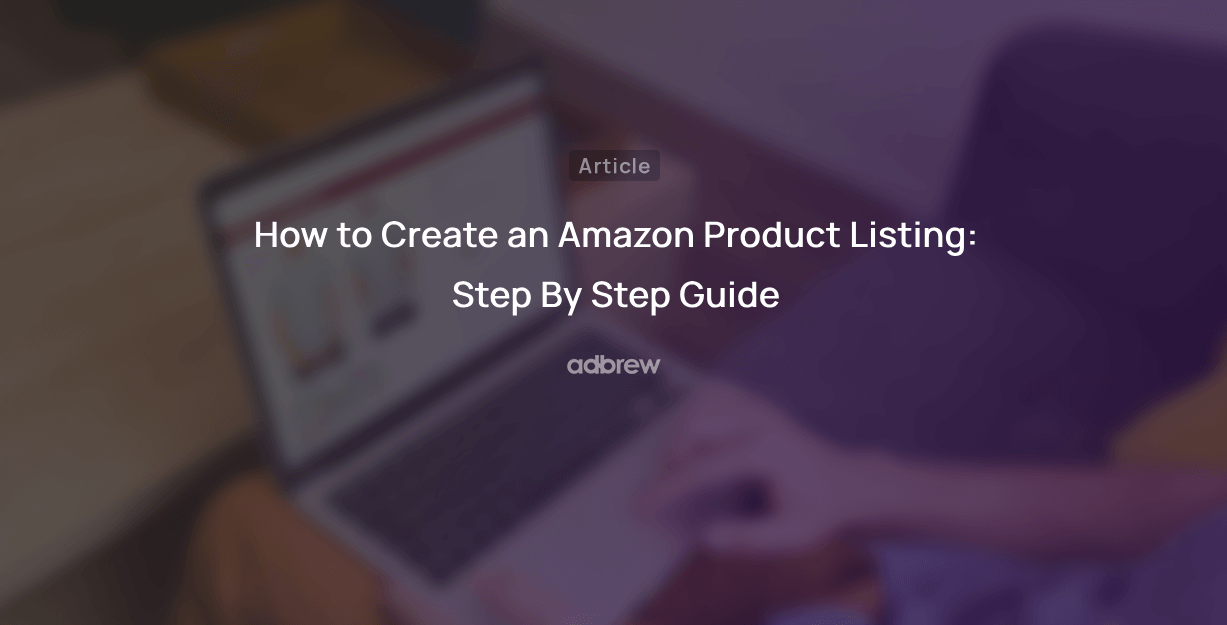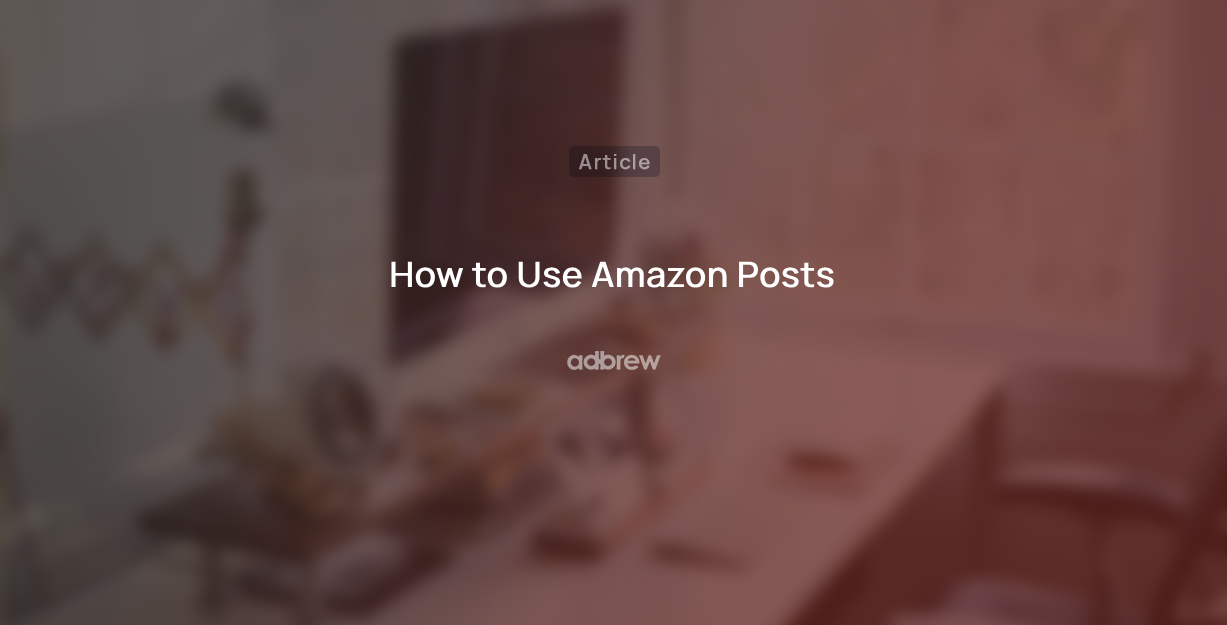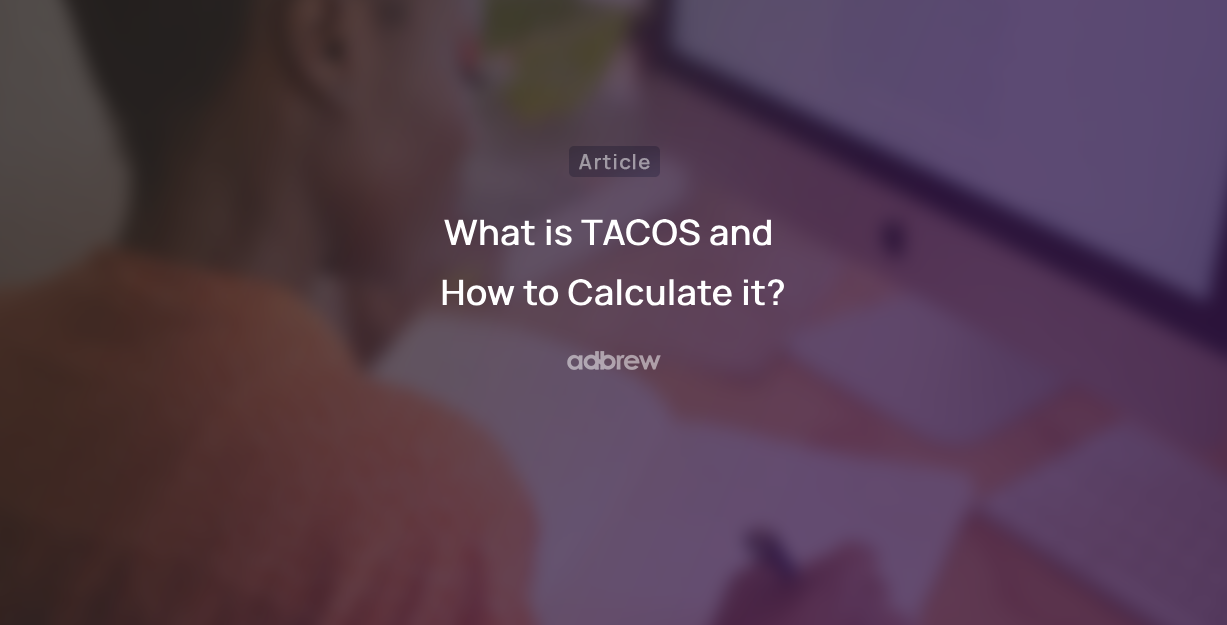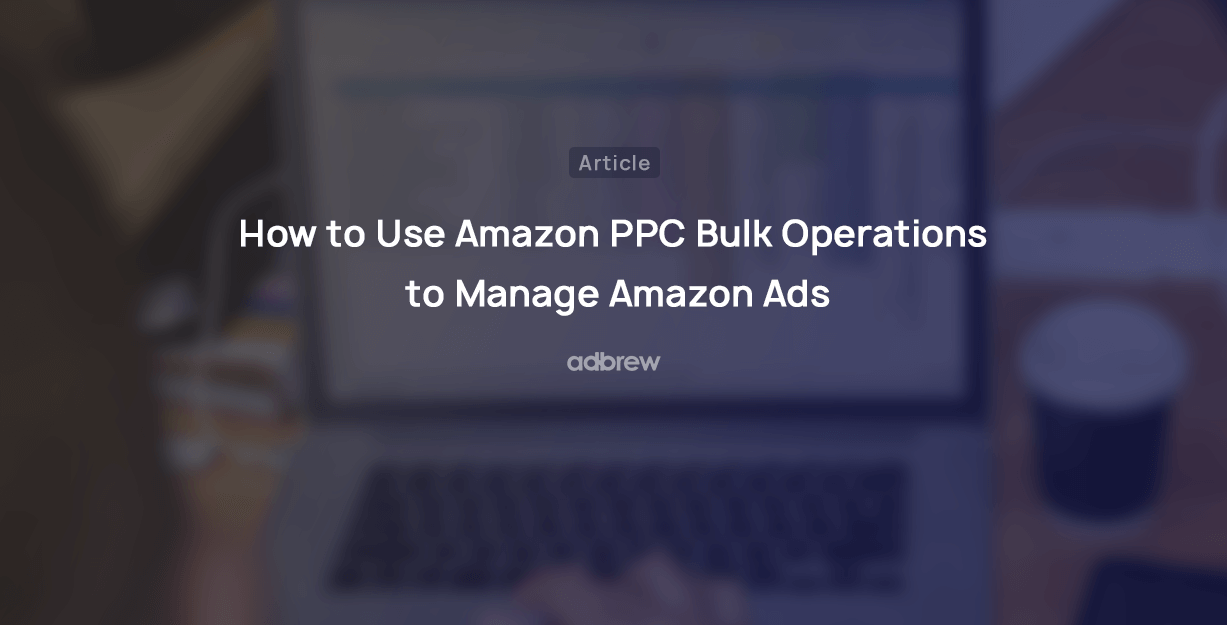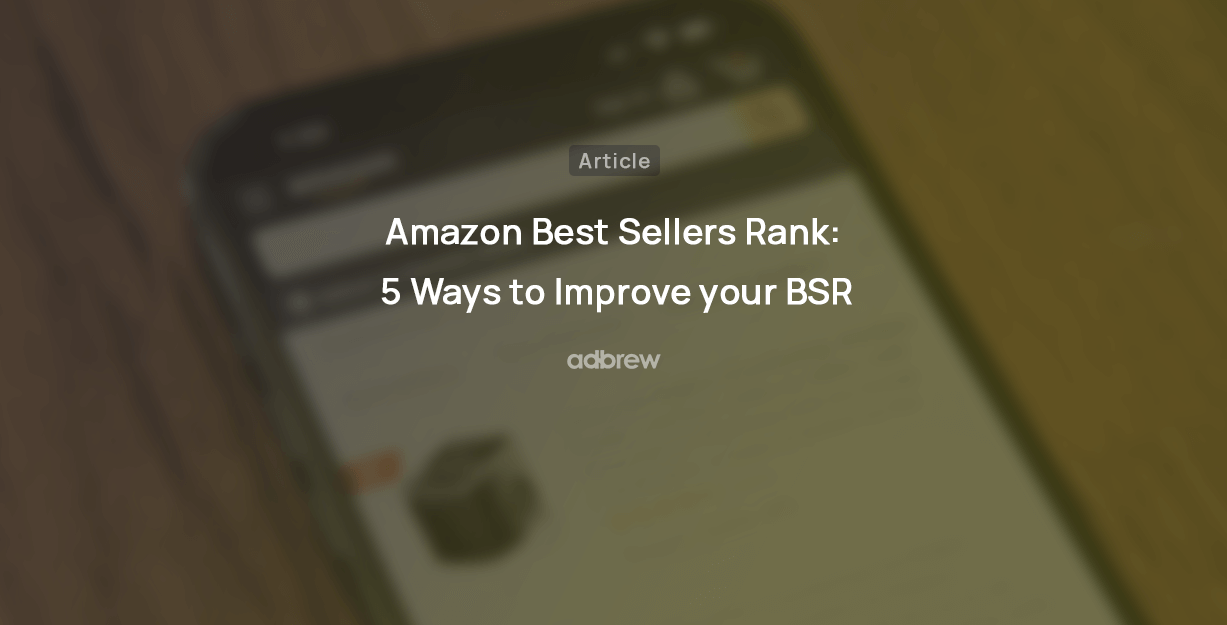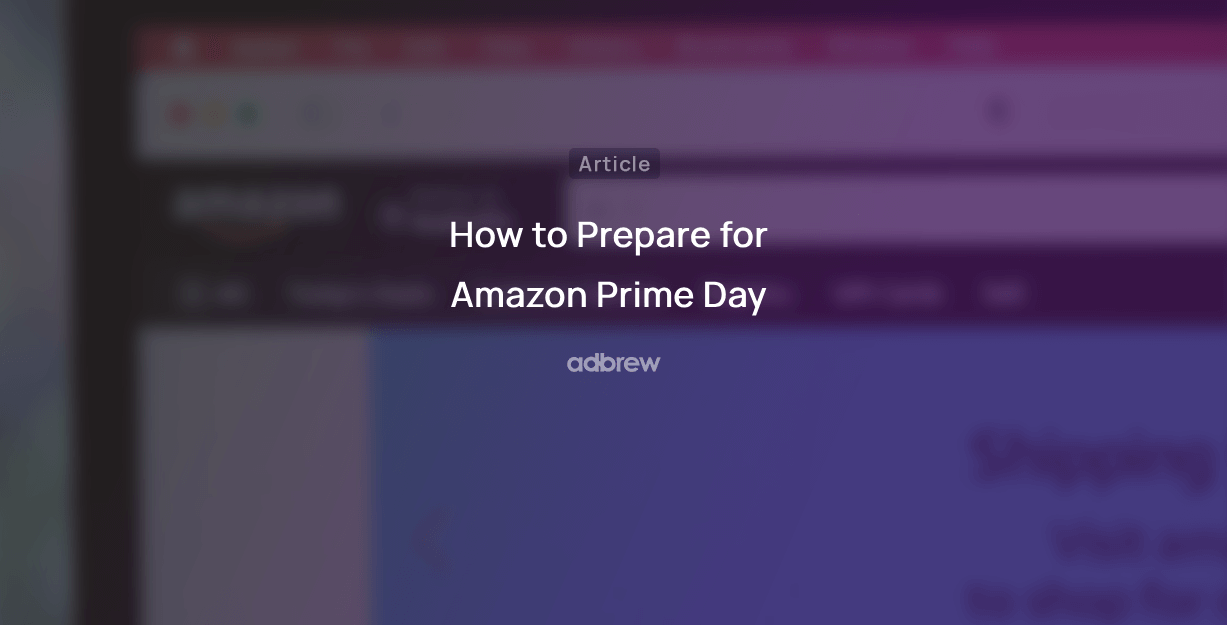
Amazon is a massive marketplace, attracting millions of customers with diverse needs, preferences, budgets, and mindsets for shopping.
To effectively cater to this diverse audience, it’s essential to offer a range of product variations that align with their specific requirements
This is where Amazon Variation Listings come into play.
In this blog, we’ll explore what Amazon variation listing means, why it’s important, and how you can create one on Amazon.
What is Amazon Variation Listing?
Amazon variation listing is a way for sellers to group together different versions of the same product on Amazon’s platform. Instead of listing each version separately, like different colors or sizes, they can put them all under one main listing.
Here’s how it works:
Let’s say you’re selling a t-shirt in five different colors and three different sizes.
Instead of creating eight separate listings for each color and size combination, you can create one listing for multiple variations of t-shirts. Within that listing, customers can choose the color and size they want from dropdown menus or buttons.
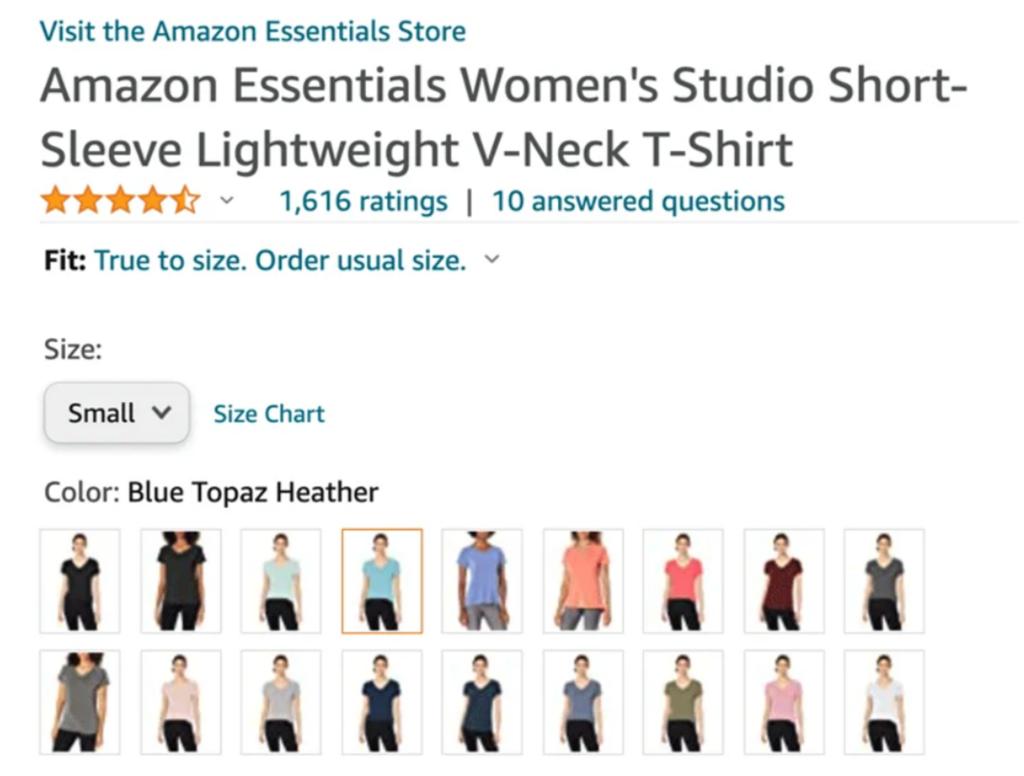
This is convenient for both sellers and customers. Sellers don’t have to manage multiple listings for the same product, which can save time and make inventory management easier.
Customers can easily see all the options available for the product they’re interested in without having to search through different listings.
Variation listings also help streamline the buying process since customers can see all the options available in one place and make their selections without navigating away from the main product page.
So, it is a win-win situation for both sellers and Shoppers on Amazon.
Structure of Amazon Variation Listing
The structure of Amazon Variation Listing is quite simple as it follows the Parent-Child Relationship. So you can also call it Parent Child Listing. The structure typically involves three main components: Parent, Child, and Variation Theme. Let’s under each of them in detail.
1. Parent Listing
A parent listing is a listing that contains all the variations of a product.
Think of it as a category where you’ll find objects of the same type, each with differences in qualities and features.
Shoppers cannot purchase a parent listing directly. Instead, the parent listing serves to link or group variations on a single page.
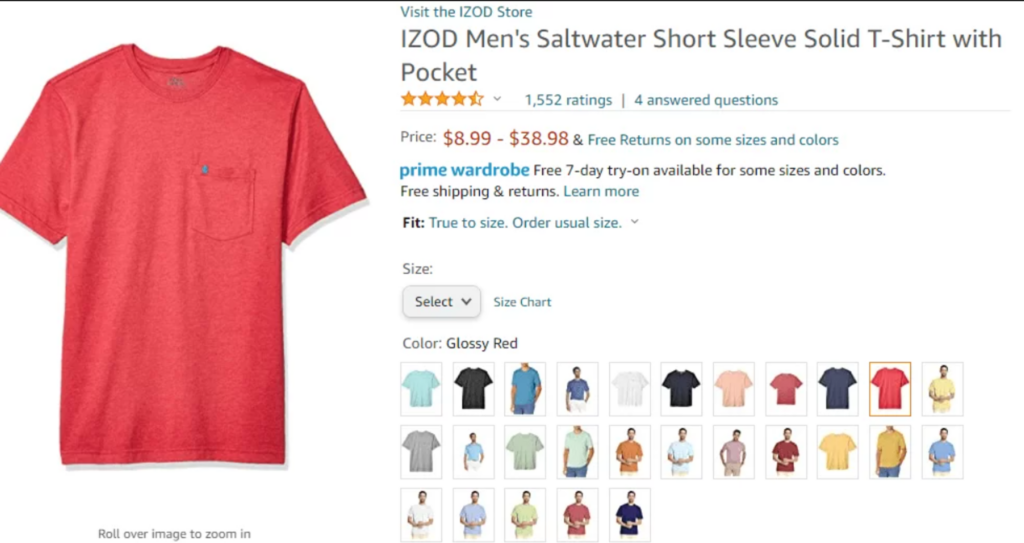
2. Child Listings
Child listings are the individual variations of the parent product. Each child listing corresponds to a specific variant, such as a different color or size.
These variations share the same product page as the parent, allowing customers to select the specific option they want to purchase.
For instance, if the parent listing is for a t-shirt available in multiple colors (e.g., red, blue, green), each color option would be represented by a child listing.
3. Variation Themes
The Variation theme refers to the attribute or dimension along which the variations are organized. It defines the specific characteristics that differentiate the child listings from each other. This helps customers navigate through the options and select the variant that best suits their preferences.
Common variation themes include:
Size: For clothing, shoes, etc.
Color: For almost any product category
Style: For variations in design or model
Pattern: Variations with different prints or textures
Flavor: For consumable products
Quantity: For products sold in different package quantities

Benefits Of Using Amazon Variation Listing
Amazon variation listings offer several advantages for sellers looking to efficiently manage their products and improve their sales strategy. Here’s a detailed breakdown of the benefits:
1. Customer Engagement
The most important outcome of using variation listing is increased customer engagement. Let’s understand this with an example.
Imagine a shopper looking for a specific type of shoe. With variations, they can browse all your color and size options within a single product page.
This eliminates the need to search for separate listings, keeping them engaged and focused on your brand’s offerings.
It’s like having a virtual showroom where customers can explore all the possibilities without leaving your product.
2. Boosted Conversion Rates
By simplifying the buying process, variations can significantly increase the likelihood of a customer completing a purchase.
Imagine encountering two similar products, one with variations and one with separate listings.
The one with variations allows for effortless comparison of sizes or colors, making the decision to buy much easier and faster. This streamlined experience translates to higher conversion rates for you.
3. Consolidated Reviews
Variations consolidate reviews for all child products under the parent listing. This creates a more robust pool of feedback for potential customers to consider.
Having a higher number of reviews, especially positive ones, builds trust and credibility for your brand, ultimately influencing buying decisions.
4. Higher Organic Ranking
Amazon’s search algorithms favor listings with a higher perceived value to customers. Variations demonstrate a wider selection within a product category, making your listing more relevant to a broader range of searches.
Additionally, the consolidated reviews under a variation listing can contribute to a stronger overall rating, which is another factor considered in search ranking.
5. Increase in Sales
The combined effect of improved customer engagement, higher conversion rates, and increased visibility through search ranking all lead to one thing: a potential surge in sales.
By offering a wider selection within a single listing, you cater to a larger audience and make it easier for them to find exactly what they’re looking for.
This translates to more sales and a more successful presence on the Amazon marketplace.
How To Create Amazon Variation Listing?
Understanding how to create an Amazon variation listing is crucial once you recognize its significance. Here’s a step-by-step guide:
Step 1: Access your Seller Central account. Navigate to the Inventory Tab, which is where you’ll initiate the creation of your Amazon listing variation.
Step 2: Under the Inventory Tab, select “Add A Product” and opt for the option “I’m adding a product that is not sold on Amazon.”
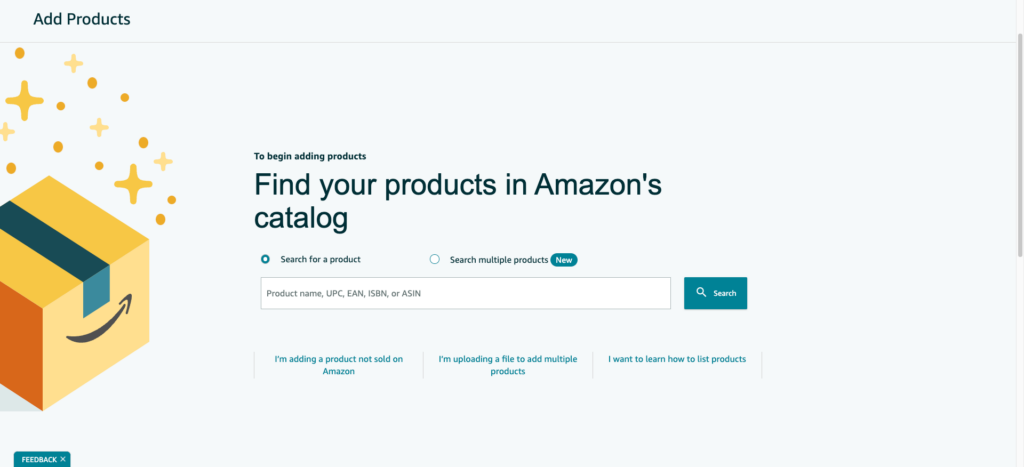
Step 3: Name your product and select the category that best fits your products.
Step 4: On the subsequent page, fill in additional details about your product such as the brand name, product ID, and any variations it may have. If your product has variations, indicate so by selecting ‘Yes’ next to “Does the product have variations?” Fill in the remaining required information and proceed by clicking Next.
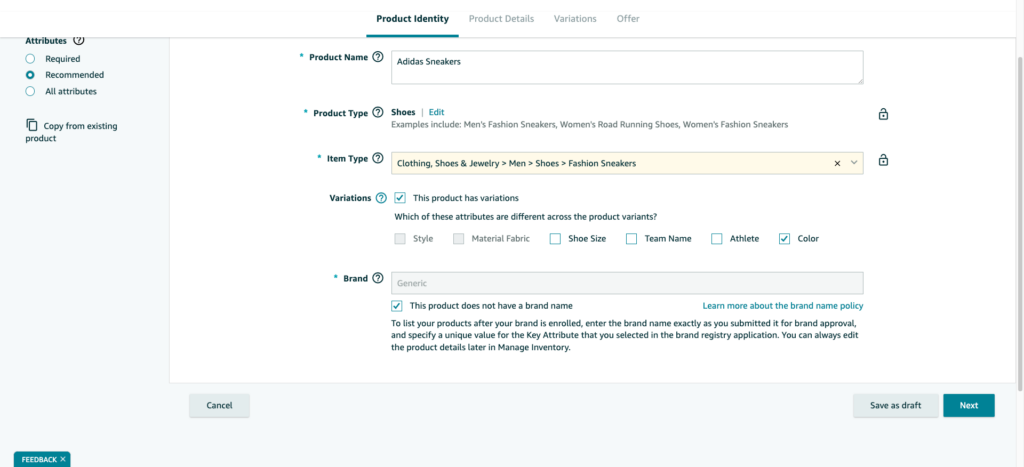
Step 5: Navigate to the Variations tab. Here, choose the type of variation your product offers and list all the available variations.
Step 6: For each variation, input specific details like product ID, product type, condition, price, quantity, etc. Ensure all necessary information is provided for every variation you’ve created.
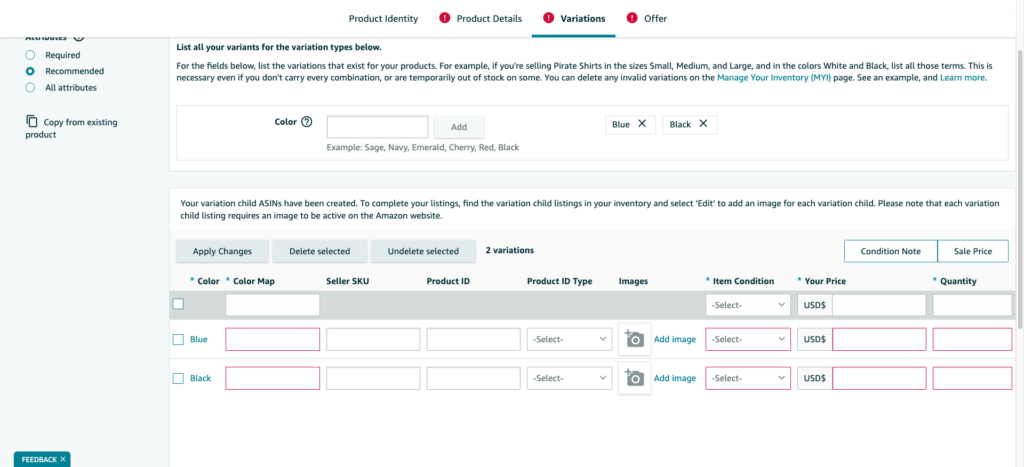
Step 7: Once you’ve added all variations and completed the listing, submit it for review.
How To Add Variations In An Existing Amazon Listing
Adding variations to an existing Amazon listing is simple and quick. Follow the below steps to add variations to an existing listing.
Step 1 – Log in to your Seller Central account and go to the inventory tab.
Step 2 – Under the inventory tab, select “Manage Inventory” to view all your listings. Choose the listing to which you want to add variations.
Step 3 – After selecting the product or parent listing, click on the “Edit” option located at the right end of the listing.

Step 4 – Upon clicking “Edit,” you’ll be directed to the product details page with different tabs. Navigate to the “Variations” tab.
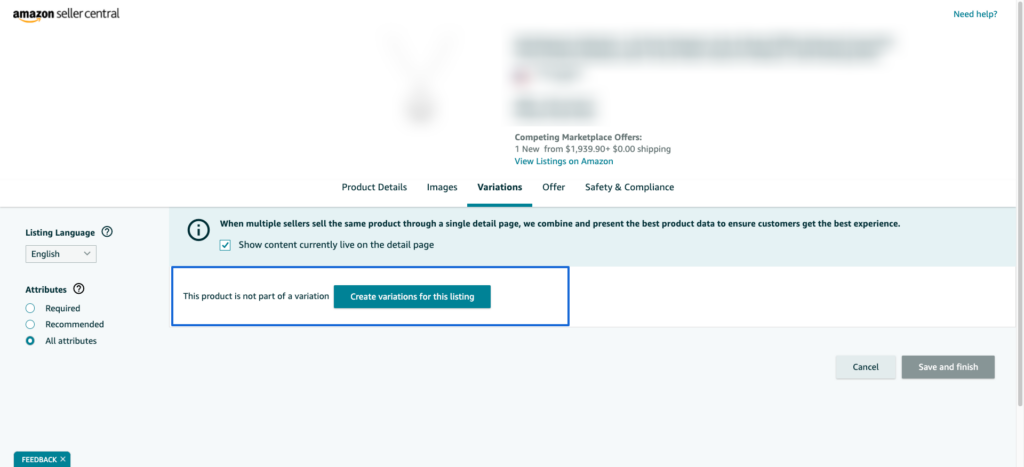
Step 5 – In the variations tab, start by selecting the variation theme or attributes you want to use. Choose one attribute at a time.
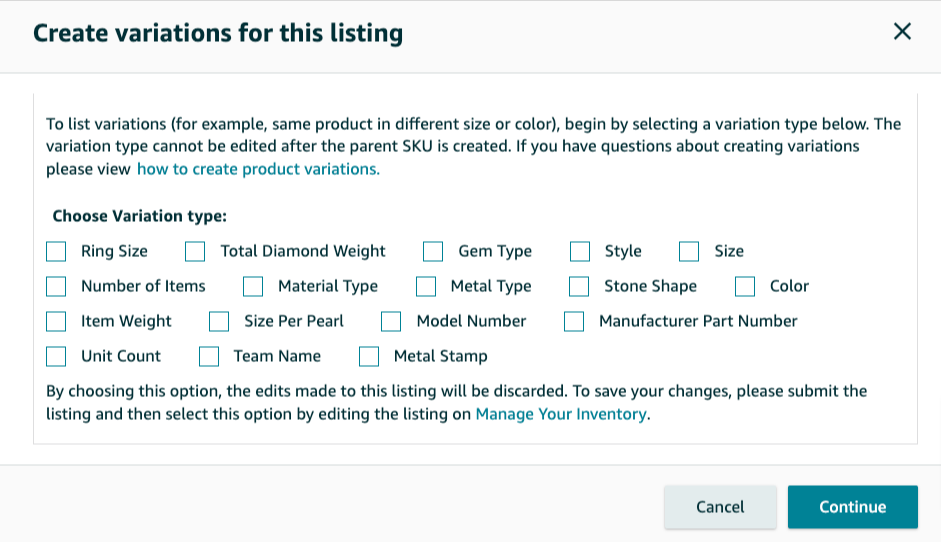
Step 6 – Once you’ve selected the attribute or variation theme, it’s time to create variations based on that theme. For instance, if you’ve chosen color as the attribute, add multiple colors as variations.

Step 7 – For each variation, input details such as product ID, type, condition, price, and quantity. If you’re using ASIN, ensure to enter the parent ASIN in the product ID field. For example, if you’ve created variations for red, blue, and green, fill in all the necessary details for each variation.
Step 8 – Once you’ve filled in the details for every variation, click on “Save and Finish.” Your existing listing will now become an Amazon Variation Listing, including all the variations you’ve created.
How To Add Variation Using Variation Wizard
Variation Wizard is a helpful tool for adding, updating, and deleting variations easily and quickly. A seller can add variations in bulk, saving time and making the process easy. Follow the steps below to add variations using the Variation Wizard.
Step 1 – Log in to your Seller Central dashboard and navigate to the Inventory tab on your dashboard.
Step 2 – Within the Inventory tab, locate and click on the “Add A Product” option. This action will direct you to a new page. Towards the bottom of this page, you’ll find the “Create Variation” section on the right-hand side. Within this section, select “Create Variation Using Variation Wizard.
Step 3 – Next, choose the option to “Add or update an existing variation family.” You’ll then be prompted to provide the product ID or ASIN to search for the product to which you wish to add a variation.
Step 4 – If someone has already published the variation for that item, you can click the Sell Your option. In this case, you don’t want to create any variation.
Step 5 – If you didn’t find the desired variation and wish to add a new one, click on “Add New Variation.”
Step 6 – Now, proceed to add the details for the variations you intend to add, including product ID, type, condition, price, quantity, etc.
Step 7 – Once you’ve filled in all the necessary details, click on “Save and Finish” to complete the process.
Tips For Amazon Variation Listing
Amazon Variation Listing is a mind-blowing feature available for free, and if a seller utilizes it well, it will result in massive sales, customer engagement, and much more. Here are some important tips for Amazon Variation Listing
Not all categories allow variations. Check during listing creation or refer to Amazon’s category-specific templates to see if variations are supported for your product type.
The parent listing should showcase the core product features. Include high-quality images that represent all variations.
Use specific and identical images for every product variation so that customers can easily classify.
Use accurate and consistent terms for each variation theme (e.g., size, color). This helps customers understand the difference between choices.
Track which variations are selling well and adjust pricing or promotions accordingly.
Use keywords and terms relevant to how customers would search for your variations.
Consider using A+ Content to showcase variations in a visually appealing way and provide additional product information, potentially boosting sales.
Wrapping Up
In conclusion, creating variations listings can significantly enhance your product’s discoverability and customer experience. By following the steps outlined in this blog, you can create effective variations that showcase the unique attributes of your offerings.
Whether you’re creating a new listing from scratch or adding variations to an existing product, taking the time to optimize your variations can significantly improve your performance on Amazon.
FAQ - Amazon Variation Listings
1. What is an Amazon variation listing?
An Amazon variation listing groups related products under a single listing, allowing customers to choose options like size, color, or style from one page.
2. What are the benefits of using variation listings?
Variation listings improve customer experience, consolidate reviews for all variations, and can increase sales by showcasing multiple options in one place.
3. What types of products are eligible for variation listings?
Products that differ only in specific attributes, like size, color, flavor, or quantity, are eligible for variations. They must belong to categories that support this feature.
4. How do I create an Amazon variation listing?
You need a parent ASIN to group the variations and individual child ASINs for each variant. These are linked together using Amazon’s inventory file templates or Seller Central.
5. Can I add or remove variations later?
Yes, you can update a variation listing by adding or removing child ASINs through Seller Central, but ensure the changes comply with Amazon’s variation guidelines.
Recent Posts
Take your Amazon PPC advertising to the next level

Related Blogs
Running Amazon ads with an empty shelf? You might as well be burning cash. Many sellers focus on optimizing bids, […]
In today’s competitive digital landscape, growing your eCommerce brand requires more than just a standalone website or a single marketplace […]
Are you an Amazon seller looking to offload excess inventory or seasonal items? The Amazon Outlet program might be just […]
Turning your bookshelf into a source of income has never been easier, thanks to Amazon. If you have books collecting […]
If you’re an Amazon seller, encountering an account suspension or policy violation can be a significant setback. But with the […]
Introduction Amazon dropshipping is an increasingly popular way to run an e-commerce business without the need to store or ship […]
Introduction The Amazon Influencer Program is a great way for content creators to turn their influence into earnings. This program […]
Introduction Amazon Kindle Direct Publishing (KDP) is a platform that allows authors to self-publish their work as ebooks or print […]
Selling on Amazon offers many opportunities for businesses, but it’s essential to understand the costs involved with Fulfillment by Amazon […]
Walmart is quickly becoming a popular platform for brands and sellers to connect with more customers. One way to boost […]
In today’s competitive retail landscape, reaching the right audience at the right time is crucial for success. Walmart’s Demand Side […]
In today’s fast-paced eCommerce landscape, shoppers demand speedy delivery. Walmart has responded by offering 2-day shipping, giving sellers on the […]
Running successful Walmart advertising campaigns takes more than just setting them up—it requires ongoing optimization. A Walmart PPC (Pay-Per-Click) audit […]
Are you ready to tap into the massive potential of Walmart Marketplace? With millions of daily visitors and a loyal […]
In the world of e-commerce, Amazon and Walmart reign supreme, dominating the retail landscape. These two giants offer vast opportunities […]
Are you a brand owner struggling to maintain control over your products on Walmart? The Walmart Brand Portal is here […]
Are you dreaming of a passive income stream from your Walmart store? The allure of an automated Walmart store with […]
Are you a seller looking to tap into the massive market of private-label brands? Walmart, one of the world’s largest […]
Tired of your Walmart products getting lost in the shuffle? In this blog post, we’ll dive into the essential strategies […]
Ever wondered why some Amazon sellers seem to have a magic touch with product bundles? It’s not luck—it’s strategy. Bundling […]
If you’re a Walmart seller looking to grow your business through retail media, Walmart Connect could be a game-changer. But […]
If you’re an Amazon seller, you may have noticed a portion of your inventory marked as “reserved” without knowing exactly […]
Have you ever wondered what managing your own Amazon orders is like? Switching from Fulfilled by Amazon (FBA) to Fulfilled […]
Walmart Marketplace offers an exciting opportunity for sellers to reach a vast audience by listing their products on Walmart’s platform. […]
Selling products on online marketplaces has become a vital strategy for businesses to reach more customers. If you’re looking to […]
Are you a Walmart seller aiming to improve your visibility and sales? In this blog, we will explore Walmart SEO, […]
As an Amazon brand owner, maintaining control over your product listings is essential to protect your brand’s reputation and customer […]
Improving your sales on Walmart starts with understanding how to consistently win the Buy Box. Securing this position can make […]
Are you an Amazon seller struggling to increase your rating? A high seller rating is crucial for attracting new customers […]
As an Amazon seller, providing the best customer service is paramount to maintaining a positive customer experience. One key metric […]
If you’re an Amazon seller and curious about Amazon IPI score and its impact on your business, this blog post […]
Introduction Starting an Amazon subscription box business presents a unique opportunity to tap into the growing trend of curated, recurring […]
Thinking about using Fulfillment by Amazon (FBA) to sell on the Amazon marketplace? Awesome! But before you box up your […]
Thinking about using Fulfillment by Amazon (FBA) to streamline your Amazon business? While FBA offers a convenient way to store […]
For FBA sellers, the Amazon Buy Box is the holy grail of product visibility. But with constant algorithm updates and […]
Have you ever wished you could offer customers pre-made packages of complementary products without the hassle of physically bundling them […]
Have you ever wanted to create a more branded and engaging presence for your products on Amazon? An Amazon storefront […]
Are you storing items on Amazon for a while? If so, it’s important to be aware of Amazon long term […]
When selling products on Amazon, it is crucial to follow their packaging requirements, rules, and guidelines. Proper packaging ensures that […]
Amazon A/B testing can significantly enhance your product listings and boost sales. This method, also known as split testing, involves […]
Have you ever browsed Amazon and stumbled upon a product with a little blue badge that reads “Amazon’s Choice“? It […]
Amazon FBA vs FBM needs to be explored, when we ship products and handle orders while selling on Amazon. With […]
Ever feel like you’re missing something in your Amazon PPC Search Terms report? You might be! Sure, they show what […]
Amazon can be a fantastic platform to reach new customers, but keeping your virtual shelves stocked can get tricky. That’s […]
Navigating Amazon as a new seller can be tough, but there are tools and programs available to help such as […]
Have you ever scrolled through an Amazon search result page and noticed product recommendations nestled alongside the standard listings? These […]
Finding time for yourself while selling on a competitive marketplace like Amazon can be challenging. As a seller, your main […]
Starting an E-commerce business has become quite easy with Amazon, but it also brings heavy competition. Millions of Amazon sellers […]
As an Amazon seller, you know the importance of getting your products seen. But with millions of listings, how do […]
Ever scrutinized an Amazon product page and noticed the cryptic “Sales Rank”? Wondering what it means and how it impacts […]
Millions of products compete for customer attention on Amazon’s search results page, making it tough for your brand to stand […]
Are you selling products on Amazon and looking to increase your sales? This blog is for you. We’ll share tips […]
Are you an Amazon seller looking to boost your brand visibility and profitability? Are you feeling stuck in the cycle […]
Ever wonder what drives your online shopping habits? Perhaps a captivating product description, or an eye-catching professional photo? As it […]
For any seller on Amazon, understanding the A9 algorithm is crucial for success. This complex algorithm dictates which products appear […]
Are you an Amazon seller looking to turn those single purchases into recurring revenue? Look no further than the Subscribe […]
Amazon has become a go-to platform for all e-commerce business owners to launch and scale their e-commerce brands online. But […]
Mother’s Day, a time to celebrate the incredible women who raised us, is a prime opportunity for Amazon sellers to […]
In the ever-competitive landscape of Amazon, ranking high in organic search results is crucial for driving sales. While you might […]
If you’ve ever found yourself scratching your head over Sessions and Pageviews on your Amazon business reports, you’re not alone. At […]
Amazon is a massive marketplace, attracting millions of customers with diverse needs, preferences, budgets, and mindsets for shopping. To effectively […]
With Amazon boasting over $575 billion in retail sales for 2023, it’s no wonder so many sellers flock to its […]
Advertising on Amazon through pay-per-click campaigns can significantly enhance product visibility and sales for sellers. However, mastering Amazon PPC, with […]
Have you heard of the terms copyright infringement and plagiarism? If so, then Amazon Brand gating won’t be unfamiliar to […]
If you are running ads on Amazon, you’ll come across a sea of data in your advertising console. But does […]
Have you heard of the terms copyright infringement and plagiarism? If so, then Amazon Brand gating won’t be unfamiliar to […]
In the fast-paced world of e-commerce, where shoppers are bombarded with choices, standing out on platforms like Amazon is paramount […]
Are you planning to start an Amazon FBA store? If so, you’ll encounter a unique term – FNSKU. This seemingly […]
As an Amazon seller, you understand the power of reviews. They’re the lifeblood of trust and conversion on the platform. […]
Are you struggling to get Amazon reviews on your product? Well, you are not alone! Reviews are the backbone of […]
Are you tired of bland Amazon product listings failing to grab attention? In today’s competitive online marketplace, standing out is […]
As an Amazon seller, understanding how your brand performs throughout the customer journey is vital for success. However, until recently, […]
As an Amazon seller, optimizing your business and maximizing profits relies heavily on data analysis. One invaluable tool for gaining […]
Are you struggling to get noticed on Amazon’s massive platform? Do your products get lost in a sea of similar […]
For any Amazon seller getting into the world of sponsored advertising, understanding the Advertising Cost of Sale (ACoS) is crucial. […]
A well-executed Amazon product launch strategy can be the key to unlocking success and gaining a competitive edge. As the […]
In the ever-evolving landscape of e-commerce, distinguishing between keywords and search terms is vital for optimizing product visibility and driving […]
Ever felt like you are throwing darts in the dark when it comes to your marketing efforts outside Amazon for […]
Amazon, the e-commerce giant, has successfully concluded a robust business year with outstanding performance in quarter 4. The most recent […]
Picture this: you have a great product on Amazon, but it’s not selling well despite having attractive images and a […]
The advertising landscape is evolving, and viewers are rapidly migrating from traditional cable TV to streaming platforms. This presents a […]
Feeling lost in the Amazon discount jungle? Struggling to reach the right customers and entice them to make the purchase? […]
Are your products getting lost in the vast ocean of Amazon listings? Do you want them to stand out, rank higher, […]
For years, Amazon sellers were in the dark. They couldn’t see what keywords customers were using to find their products, […]
Selling on Amazon can be tough with so many others doing the same in your category. That’s why it’s super […]
For Amazon sellers, understanding their customers has often felt like navigating a maze without a map. The missing link? A […]
Have you ever felt like your Amazon advertising campaigns are lost in a tangled jungle of keywords? You’re not alone. […]
When did you last give your Amazon PPC account a checkup? Regular Amazon PPC audits are crucial to ensure the […]
Embarking on the path of online selling? If so, you’re likely aware that Amazon is your ultimate destination. With a […]
Ever felt like your product is lost in the vast Amazon jungle? You’re not alone. With millions of shoppers actively […]
Amazon Sellers selling on the Amazon marketplace usually utilize Amazon advertising without keeping a close eye on the TACoS metric. […]
The rush of Black Friday and Cyber Monday might be over, but the opportunity for continued sales growth extends beyond […]
In the fierce Amazon advertising domain, where competition rises and costs increase, understanding and keeping track of the right metrics […]
Have you ever felt the frustration of campaigns going out of budget, leading to missing out on potential sales, or, […]
Amazon PPC campaigns can be a powerful tool for driving traffic and sales to your products. However, without proper structure, they […]
Whether you are creating a new advertising campaign or optimizing existing ones, doing it manually from the Amazon ad console […]
Want to know what search terms people use to visit or purchase your product on Amazon? If yes, you’re in […]
When you are spending dollars or even more to get a click on your Amazon ads, you want to ensure […]
Are you an Amazon seller looking to maximize your profits and minimize your advertising costs? If so, you’re not alone. Many […]
Are you exclusively relying on traditional metrics such as CTR, CPC, CVR, or ROAS to make your campaign optimization decisions? […]
Navigating the ever-evolving landscape of Amazon’s online marketplace is essential for any seller looking to thrive on the platform. Among […]
As the holiday season approaches, businesses are gearing up for the highly anticipated Q4 rush. To ensure a successful Q4, […]
Do you regularly review your Amazon advertising reports? If not, you may be missing out on numerous opportunities. Amazon […]
Whether you’ve just launched a new product or have been selling on Amazon for a while, advertising on the platform […]
Amazon PPC bidding strategies that you choose play a significant role in the success of your Amazon Ads campaigns. As […]
Have you ever heard of a “catch-all campaign”? This single campaign can generate extra sales for you at a very […]
Amazon Prime Day is one of the largest global e-commerce sales events, attracting millions of customers worldwide. But how do […]
Are you looking to boost your brand’s visibility and drive more sales on Amazon? Look no further than Amazon Sponsored […]
Succeeding on Amazon in 2024 isn’t easy. Just listing your products and hoping for the best won’t work anymore. You […]
Are you bidding the same amount for all your ad placements on Amazon? If yes, then you’re missing out on […]
Whether you are looking to boost product discovery or target audiences further down the sales funnel who have already engaged […]
We, at Adbrew catalyze millions of dollars of ad spend monthly through our platform, with Sponsored Product Ads being […]
Do you want to know how many clicks you should give a search term before adding it as negative in […]
Think of your product listing as a guiding light on the Amazon marketplace. It’s your chance to grab attention, tell […]
It is no longer a secret that shopping behavior on Amazon varies over the day. This is the reason why […]
Are you struggling to get the most out of your advertising budget on Amazon? Do you find that your campaigns […]
Ever run an Amazon Ad campaign and wondered why some sales weren’t directly linked to the products you advertised? That’s […]
If you’re managing Amazon PPC ads, it’s essential to have an effective and organized approach for target harvesting and movement. […]













